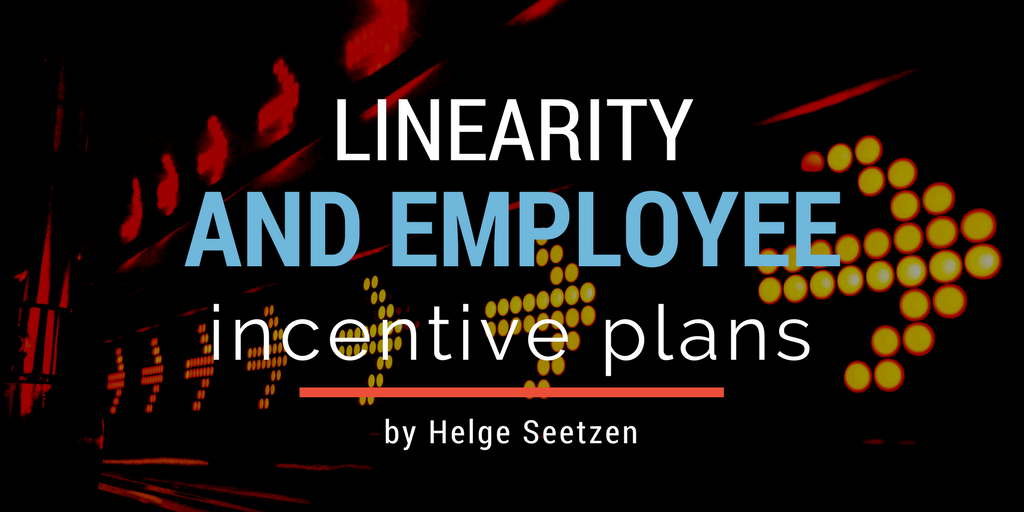In my last blog post I talked about the fundamentals of effective employee incentive plans: Proportionality, Transparency, Appropriateness, and Certainty. To my mind of thinking, creating linearity in your employee incentive plans is essential to achieve Transparency and Proportionality, and I’d like to elaborate on that a bit using the TandemLaunch incentive plan as an example. My upfront disclaimer though is that TandemLaunch enjoys a few luxuries that make it a bit easier to come up with these solutions than it is for many companies. We are privately held, have no outside investors, and have a large enough scope with 30+ employees for it to be worthwhile to do some of the legal work that underlies this type of incentive plan. As a result, all of this might not map onto your startup or company.
Transparency and Proportionality really go hand in hand. Proportionality ensures that effort is fairly recognized, and transparency means you can see and, therefore, act on the incentive mechanism. We achieve this with the TandemLaunch incentive plan by eliminating a lot of traditional nonlinear aspects of incentive plans. There are two different areas linearity or non-linearity can exist: in allocation, or in vesting.
Allocation Linearity. Those who receive equity, usually founders and investors, have several inherit advantages over employees who usually receive stock options. Stock options, apart from the legal rights and tax disadvantages associated with them, have a strike price and that immediately introduces non-linearity.
Let me give an example. Two employees join a startup. The first joins a day before a small investment round (share price of the last round at $2/share becomes his strike price), the other starts the day after (share price of the seed round at $4/share becomes her strike price). Afterwards they both work the same, they have the same title, they hold the same role, and they perform at the same level all for 4 long years. Even though the single day difference of their employment is virtually trivial after 4 years, the later employee will get significantly less money during a liquidity event. A hugely successful exit will wipe out this difference but most deals don’t achieve that. More commonly, the exit will be a modest multiple of the last round which can result in the second employee getting completely screwed (a $6/share liquidity event will yield $4/share vs. $2/share – doubling the stake for the person who joined a day earlier).
At TandemLaunch we avoid that non-linearity by issuing reverse vesting shares to all employees. This is a relatively easy way to overcome the tax and strike price non-linearity. Reverse vesting restricted stock is becoming quite popular for this purpose and I would encourage everybody to consider them as an option for incentive compensation.
Vesting Linearity. The next non-linearity that you get in non-traditional incentive plans lies in the vesting period. Regardless of whether you vest stock options or you reverse vest shares, you have the problem of long cycle vesting periods. Things like vesting on an annual basis, vesting over a fixed time period, or having a one year cliff that your vesting only starts after (e.g. after the first year of service). There are some rational reasons for all these things, but they all introduce non-linearity. That’s a problem because the guy who holds un-accelerated stock and whose one year cliff period ends three days after the acquisition of the company gets nothing, while the guy signing up three days earlier gets a payout, which intuitively just does not seem fair.
Accelerated and non-accelerated stock can introduce further non-linearity. I was recently interviewing a candidate for an executive role who, in her past company, had only received non-accelerated stock options with a 4 year vesting period. After a year she was tasked with negotiating the sale of the company. Her colleague at the negotiating table had a similar amount of stock but with acceleration. Talk about a recipe for disaster. Half of the negotiating team wants to close as fast as possible, the other gains personal wealth for every month that the negotiations are stalled (at a 4:1 gap if you are in the first year of a four year vesting period). This just screams misalignment of interests, and misalignment is what kills companies.
The TandemLaunch incentive plan overcomes some of these vesting issues by using a very straight forward, linear vesting mechanism (in our case a reverse vesting mechanism). We base it on the assumption that all the shares belong to employees anyway, and the buyback of these shares occurs just before the liquidity event, regardless of when that event may be. The number of shares employees keep after the buyback are proportional to the time in weeks that they spent employed at the company, at whatever full time equivalent rate, divided by the total period from founding to liquidity event for the company. This creates a perfectly linear system. While there are some issues here around share buybacks, like forced drag along and the like, you can paper over these with the appropriate documentation [*].
Introducing linearity this way does not imply the risk profile of the company necessarily needs to be the same. It just means that you are adjusting the risk profiles in the magnitude of the grant rather than the mechanism of vesting. So somebody who joins a startup later might very well receive a smaller equity grant than somebody who joins early, but their vesting mechanism is same. That means their reward for their service should be linear to their service, relative to the duration of the project or the company.
[*] This model works because TandemLaunch incubates new companies on a frequent basis and our employees receive equity in those ventures rather than TandemLaunch (thus allowing us to frequently issue equity at nominal value and to new hires). Your mileage may vary in a traditional “going for decades” venture with monotonically raising share price.



